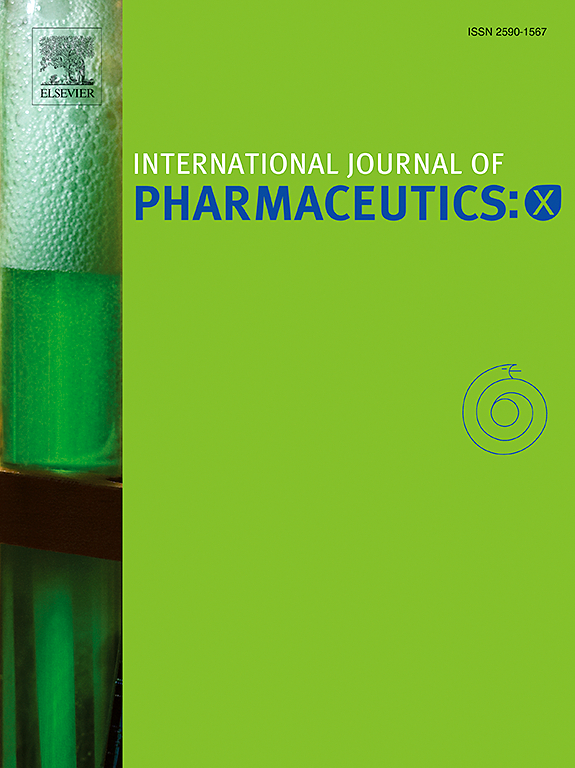选择性激光烧结不同的药物和聚合物层作为单独剂量片剂的新制造策略
IF 6.4
2区 医学
Q1 PHARMACOLOGY & PHARMACY
引用次数: 0
摘要
选择性激光烧结(SLS)是一种新兴的增材制造技术,具有生产个性化药物的潜力。在这项研究中,我们研究了一种新的简化配方方法,用于基于sls的单剂量多层片剂的生产,这些片剂含有不同层次的纯活性药物成分(API)和赋形剂。选择吲哚美辛(IND)为模型原料药,聚乙烯醇(PVA)为赋形剂。与需要粉末混合的传统方法不同,这种方法利用IND和PVA的单独粉末罐,可以在单步程序中直接打印交替层。我们通过改变IND层数,在不同成分中保持一致的印刷参数,并确认原料药在产品中的化学稳定性,成功地制备了具有控制IND剂量的片剂。由于SLS通常用于热塑性物质,因此成功烧结纯IND层是该研究的关键成就,因为这种结晶API通常不能单独打印。能量色散x射线光谱(EDS)证实了不同原料药和赋形剂层的成功形成。差示扫描量热法(DSC)表征表明,烧结过程使IND部分非晶化,这可能会提高溶出度和生物利用度。溶出度测试表明,与原IND粉相比,印刷片剂的溶出率有所提高。该研究成功地证明了基于sls的个性化剂量生产的可能性,省去了粉末混合步骤。用最少的赋形剂和简化的加工过程创造个体化剂量的能力,代表了进一步研究临床环境(包括医院和基于药房的药物生产)的SLS的一步。本文章由计算机程序翻译,如有差异,请以英文原文为准。

Selective laser sintering of distinct drug and polymer layers as a novel manufacturing strategy for individually dosed tablets
Selective Laser Sintering (SLS) is an emerging additive manufacturing technology with potential for the production of personalized pharmaceuticals. In this study, we investigated a novel simplified formulation approach in SLS-based manufacturing of individually dosed, multi-layered tablets with distinct layers of pure active pharmaceutical ingredient (API) and excipient. Indomethacin (IND) was chosen as the model API, and polyvinyl alcohol (PVA) served as the excipient. Unlike conventional methods requiring powder blending, this approach utilizes separate powder tanks for IND and PVA, enabling direct printing of alternating layers in a single-step procedure.
We successfully fabricated tablets with controlled IND doses by varying the number of IND layers, maintaining consistent printing parameters across different compositions and confirming the API's chemical stability in the product. Since SLS is conventionally used for thermoplastic substances, the successful sintering of pure IND layers was a key achievement in the study, as this crystalline API is typically not printable separately. Energy dispersive X-ray spectroscopy (EDS) demonstrated the successful formation of distinct API and excipient layers. Differential scanning calorimetry (DSC) characterization revealed that the sintering process partially amorphized IND, which may enhance dissolution and bioavailability. Dissolution testing indicated that the printed tablets exhibited improved dissolution rates compared to raw IND powder.
The study successfully demonstrated the possibility of SLS-based production for personalized dosing by omitting powder blending steps. The ability to create individualized dosages with minimal excipients and simplified processing represents a step toward further investigation of SLS for clinical settings, including hospital and pharmacy-based drug production.
求助全文
通过发布文献求助,成功后即可免费获取论文全文。
去求助
来源期刊

International Journal of Pharmaceutics: X
Pharmacology, Toxicology and Pharmaceutics-Pharmaceutical Science
CiteScore
6.60
自引率
0.00%
发文量
32
审稿时长
24 days
期刊介绍:
International Journal of Pharmaceutics: X offers authors with high-quality research who want to publish in a gold open access journal the opportunity to make their work immediately, permanently, and freely accessible.
International Journal of Pharmaceutics: X authors will pay an article publishing charge (APC), have a choice of license options, and retain copyright. Please check the APC here. The journal is indexed in SCOPUS, PUBMED, PMC and DOAJ.
The International Journal of Pharmaceutics is the second most cited journal in the "Pharmacy & Pharmacology" category out of 358 journals, being the true home for pharmaceutical scientists concerned with the physical, chemical and biological properties of devices and delivery systems for drugs, vaccines and biologicals, including their design, manufacture and evaluation. This includes evaluation of the properties of drugs, excipients such as surfactants and polymers and novel materials. The journal has special sections on pharmaceutical nanotechnology and personalized medicines, and publishes research papers, reviews, commentaries and letters to the editor as well as special issues.
 求助内容:
求助内容: 应助结果提醒方式:
应助结果提醒方式:


